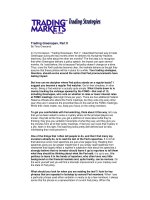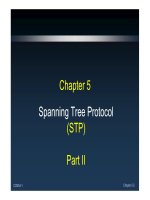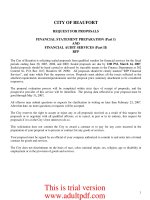CNNA3-Chapter 5: Part II pdf
Bạn đang xem bản rút gọn của tài liệu. Xem và tải ngay bản đầy đủ của tài liệu tại đây (6.46 MB, 33 trang )
CCNA3-1
Chapter 5-2
Chapter 5Chapter 5
Spanning Tree ProtocolSpanning Tree Protocol
(STP) (STP)
Part IIPart II
CCNA3-2
Chapter 5-2
Spanning Tree Protocol (STP)Spanning Tree Protocol (STP)
PVST+, RTSP and Rapid PVST+PVST+, RTSP and Rapid PVST+
PerPer VLAN Spanning TreeVLAN Spanning Tree (PVST)(PVST)
Multiple Spanning Tree ProtocolMultiple Spanning Tree Protocol (MSTP)(MSTP)
Rapid PerRapid Per VLAN Spanning Tree PlusVLAN Spanning Tree Plus (Rapid PVST+)(Rapid PVST+)
Rapid Spanning TreeRapid Spanning Tree (RSTP)(RSTP)
PerPer VLAN Spanning Tree PlusVLAN Spanning Tree Plus (PVST+)(PVST+)
CCNA3-3
Chapter 5-2
Cisco and IEEE STP VariantsCisco and IEEE STP Variants
CCNA3-4
Chapter 5-2
•• Cisco PVST+Cisco PVST+::
•• A network can run an STP instance for A network can run an STP instance for each VLANeach VLAN in the in the
network.network.
•• Cisco proprietary.Cisco proprietary.
•• More than one trunkMore than one trunk can block for a VLAN.can block for a VLAN.
•• Load sharingLoad sharing can be implemented.can be implemented.
•• Means that Means that all switchesall switches in the network are engaged in in the network are engaged in
convergingconverging the network.the network.
•• Switch ports have to accommodate the Switch ports have to accommodate the additional additional
bandwidthbandwidth used for BPDUs.used for BPDUs.
•• DefaultDefault for Cisco 2960 switches.for Cisco 2960 switches.
PVST+ (Cisco)PVST+ (Cisco)
CCNA3-5
Chapter 5-2
PVST+ (Cisco)PVST+ (Cisco)
Extended SystemExtended System IDID
CCNA3-6
Chapter 5-2
PVST+ (Cisco)PVST+ (Cisco)
Extended SystemExtended System IDID
CCNA3-7
Chapter 5-2
Configure PVST+Configure PVST+
CCNA3-8
Chapter 5-2
•• IEEE 802.1w RSTPIEEE 802.1w RSTP::
•• What is it?What is it?
•• Is an Is an evolution of the 802.1Devolution of the 802.1D standard.standard.
•• Terminology remains primarily the same.Terminology remains primarily the same.
•• Most parameters have been left unchanged.Most parameters have been left unchanged.
•• Speeds the recalculationSpeeds the recalculation of the spanning tree on a of the spanning tree on a
topology change.topology change.
•• Much Much faster convergencefaster convergence
•• RedefinesRedefines the type of ports and their state.the type of ports and their state.
•• Alternate or backup ports can immediately changeAlternate or backup ports can immediately change to to
a forwarding state without waiting for the network to a forwarding state without waiting for the network to
converge.converge.
Rapid SpanningRapid Spanning Tree Protocol (RSTP)Tree Protocol (RSTP)
CCNA3-9
Chapter 5-2
•• IEEE 802.1w RSTPIEEE 802.1w RSTP::
•• Characteristics:Characteristics:
•• Preferred protocolPreferred protocol
for preventingfor preventing
Layer 2 loops. Layer 2 loops.
•• CiscoCisco proprietaryproprietary
enhancementsenhancements, such as UplinkFast and , such as UplinkFast and
BackboneFast, are not compatible with RSTP.BackboneFast, are not compatible with RSTP.
•• Retains Retains backward compatibility backward compatibility to 802.1D. to 802.1D.
•• Keeps theKeeps the same BPDU formatsame BPDU format as IEEE 802.1D with as IEEE 802.1D with
the the version field is set to 2version field is set to 2 to indicate RSTP. to indicate RSTP.
•• Port can safely transition to the Port can safely transition to the forwarding state forwarding state
without having to rely on any timer configuration.without having to rely on any timer configuration.
Rapid SpanningRapid Spanning Tree Protocol (RSTP)Tree Protocol (RSTP)
CCNA3-10
Chapter 5-2
Rapid SpanningRapid Spanning Tree Protocol (RSTP)Tree Protocol (RSTP)
802.1w (RSTP)802.1w (RSTP)
Switch sends an Switch sends an
information BPDU every information BPDU every
hello time (2 seconds)hello time (2 seconds)
even if no BPDU has even if no BPDU has
been received on the been received on the
root port.root port.
802.1D (STP)802.1D (STP)
Switch Switch onlyonly sends an sends an
information BPDU when information BPDU when
it receives one on the it receives one on the
root port.root port.
CCNA3-11
Chapter 5-2
•• Rapid Transition to Forwarding StateRapid Transition to Forwarding State::
•• Rapid transition is the most important feature introduced Rapid transition is the most important feature introduced
by 802.1w. by 802.1w.
•• The legacy STA passively waited for the network to The legacy STA passively waited for the network to
converge before it turned a port into the forwarding converge before it turned a port into the forwarding
state. state.
•• The new rapid STP is able to actively confirm that a The new rapid STP is able to actively confirm that a
port can safely transition to the forwarding state port can safely transition to the forwarding state
without having to rely on any timer configurationwithout having to rely on any timer configuration. .
•• In order to achieve fast convergence on a port, the In order to achieve fast convergence on a port, the
protocol protocol relies upon two new variablesrelies upon two new variables::
•• Edge PortsEdge Ports
•• Link Type. Link Type.
Rapid SpanningRapid Spanning Tree Protocol (RSTP)Tree Protocol (RSTP)
CCNA3-12
Chapter 5-2
•• Edge PortsEdge Ports::
•• An edge port is a switch port that is An edge port is a switch port that is never intendednever intended to be to be
connected to another switch device.connected to another switch device.
•• It immediately transitions to theIt immediately transitions to the forwarding stateforwarding state when when
enabled.enabled.
•• Does this sound like anything we’ve already discussed?Does this sound like anything we’ve already discussed?
Rapid SpanningRapid Spanning Tree Protocol (RSTP)Tree Protocol (RSTP)
•• NonNon Edge PortsEdge Ports::
•• A nonA non edge port is a switch port that is edge port is a switch port that is always intendedalways intended to to
be connected to another switch device.be connected to another switch device.
Cisco Cisco PortfastPortfast
NonNon Edge PortsEdge Ports
Edge PortsEdge Ports
CCNA3-13
Chapter 5-2
•• Link TypesLink Types::
•• The link type provides a categorization for each port The link type provides a categorization for each port
participating in RSTP. participating in RSTP.
•• NonNon edgeedge ports are categorized into ports are categorized into two link typestwo link types::
•• PointPoint toto point:point:
•• Connects to a single network device.Connects to a single network device.
•• Shared:Shared:
•• Connects to a shared media where more switches Connects to a shared media where more switches
may exist.may exist.
•• The link type is The link type is automaticallyautomatically derived from the derived from the duplex duplex
mode of a portmode of a port but this can be overridden. but this can be overridden.
Rapid SpanningRapid Spanning Tree Protocol (RSTP)Tree Protocol (RSTP)
CCNA3-14
Chapter 5-2
•• Link TypesLink Types::
•• However, before the link type parameter is considered, However, before the link type parameter is considered,
RSTP must determine the port role.RSTP must determine the port role.
•• Root Ports:Root Ports:
•• Do notDo not use the link type parameter. use the link type parameter.
•• Alternate and Backup Ports:Alternate and Backup Ports:
•• Do notDo not use the link type parameter in most cases. use the link type parameter in most cases.
•• Designated Ports:Designated Ports:
•• Make the most use of the link type parameter only Make the most use of the link type parameter only
if it is a pointif it is a point toto point link.point link.
Rapid SpanningRapid Spanning Tree Protocol (RSTP)Tree Protocol (RSTP)
CCNA3-15
Chapter 5-2
•• Port StatesPort States::
•• An RSTP topology change causes a transition to the An RSTP topology change causes a transition to the
forwarding state through either forwarding state through either explicit handshakesexplicit handshakes or a or a
proposal and agreement process and synchronizationproposal and agreement process and synchronization
•• With RSTP, the With RSTP, the rolerole of a port is of a port is separatedseparated from the from the
statestate of a port. of a port.
•• For example, a designated port could be in the For example, a designated port could be in the
discarding state temporarily, even though its final discarding state temporarily, even though its final
state is to be forwarding.state is to be forwarding.
Rapid SpanningRapid Spanning Tree Protocol (RSTP)Tree Protocol (RSTP)
CCNA3-16
Chapter 5-2
•• Port StatesPort States::
•• Discarding:Discarding:
•• Prevents the forwarding of data frames.Prevents the forwarding of data frames.
•• Learning:Learning:
•• Accepts data frames to populate the MAC table.Accepts data frames to populate the MAC table.
•• Forwarding:Forwarding:
•• Forwards data frames and determines the topology.Forwards data frames and determines the topology.
Rapid SpanningRapid Spanning Tree Protocol (RSTP)Tree Protocol (RSTP)
CCNA3-17
Chapter 5-2
Rapid SpanningRapid Spanning Tree Protocol (RSTP)Tree Protocol (RSTP)
STPSTP
RSTPRSTP
CCNA3-18
Chapter 5-2
•• Port RolesPort Roles::
•• The port role defines the ultimate purpose of a switch port The port role defines the ultimate purpose of a switch port
and how it handles data frames. Port roles and port and how it handles data frames. Port roles and port
states are able to transition independently of each other. states are able to transition independently of each other.
•• RootRoot PortPort
•• DesignatedDesignated PortPort
•• AlternateAlternate PortPort
•• BackupBackup PortPort
•• Creating the additional port roles allows RSTP to define a Creating the additional port roles allows RSTP to define a
standby switch port standby switch port before a failurebefore a failure or topology change. or topology change.
Rapid SpanningRapid Spanning Tree Protocol (RSTP)Tree Protocol (RSTP)
CCNA3-19
Chapter 5-2
•• Port RolesPort Roles::
Rapid SpanningRapid Spanning Tree Protocol (RSTP)Tree Protocol (RSTP)
CCNA3-20
Chapter 5-2
•• In IEEE 802.1D STP:In IEEE 802.1D STP:
•• A A designated port must waitdesignated port must wait two times the forward delay two times the forward delay
before transitioning the port to the forwarding state.before transitioning the port to the forwarding state.
•• RSTP:RSTP:
•• Significantly speeds up the recalculation process after a Significantly speeds up the recalculation process after a
topology change.topology change.
•• It It converges on a linkconverges on a link byby link basislink basis and and does not rely on does not rely on
timerstimers expiring before ports can transition.expiring before ports can transition.
•• Only on Only on edge portsedge ports and and pointpoint toto pointpoint links.links.
RSTP Proposal and Agreement ProcessRSTP Proposal and Agreement Process
CCNA3-21
Chapter 5-2
RSTP Proposal and Agreement ProcessRSTP Proposal and Agreement Process
CCNA3-22
Chapter 5-2
•• Rapid PVST+ is a Cisco implementation of RSTPRapid PVST+ is a Cisco implementation of RSTP. .
•• Supports spanning tree for Supports spanning tree for each VLANeach VLAN. .
•• Rapid STP variantRapid STP variant to use in Ciscoto use in Cisco based networks. based networks.
Configuring RapidConfiguring Rapid PVST+PVST+
CCNA3-23
Chapter 5-2
•• Know where the root is:Know where the root is:
Design STP for Trouble AvoidanceDesign STP for Trouble Avoidance
Either Either ––
not both!not both!
CCNA3-24
Chapter 5-2
•• Know where the root is:Know where the root is:
Design STP for Trouble AvoidanceDesign STP for Trouble Avoidance
Either Either ––
not both!not both!
CCNA3-25
Chapter 5-2
•• Minimize the Number of Blocked Ports:Minimize the Number of Blocked Ports:
•• The only critical action that STP takes is the blocking of The only critical action that STP takes is the blocking of
ports. ports.
•• A good way to limit the risk inherent in the use of STP is A good way to limit the risk inherent in the use of STP is
to reduce the number of blocked ports as much as to reduce the number of blocked ports as much as
possible.possible.
•• In nonIn non hierarchical networks you might need to tune the hierarchical networks you might need to tune the
STP cost parameter to STP cost parameter to decide which ports to blockdecide which ports to block. .
Design STP for Trouble AvoidanceDesign STP for Trouble Avoidance









